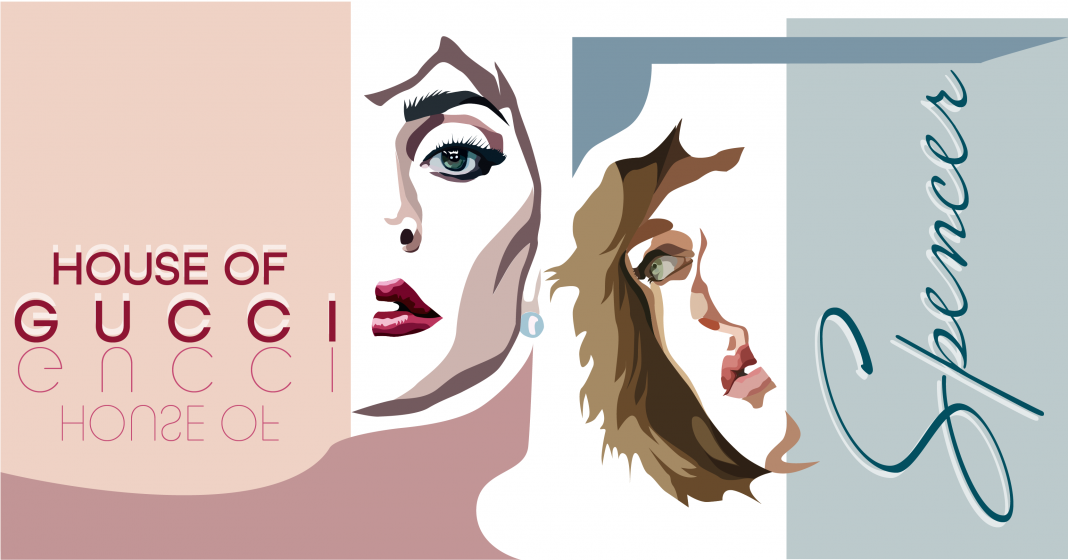From the hedonistic maximalism of Ridley Scott’s “House of Gucci” to the ominous swinging sixties-era of Edgar Wright’s “Last Night in Soho” to the British glamor of Pablo Larrain’s “Spencer,” the fall season brought fashion to the frontier in film.
The most overt nod to the fashion sector, “House of Gucci” serves as an opulent black widow tale of the titans of Italian luxury. Set in the picturesque backdrop of fashion epicenters like Milan and St. Moritz, the story chronicles the relationship between socialite Patricia Reggiani and Gucci heir Maurizio Gucci, following early flirtations to years of romance fueled by excessive indulgence to their souring breakdown and climactic assassination of Maurizio.
Director Ridley Scott’s previous collaboration with costume designer Janty Yates on his film “Gladiator” earned Yates an Oscar Award and a sizable reputation for historical costumery. For “House of Gucci’,” Yates brings her expertise and the elaborate air of historical melodrama.
The film may be set in contemporary times, but familial feuds were no less dynamic in the eighties than the Roman times. Although the film features plenty of archival Gucci dress, a significant portion of the wardrobe is not the namesake fashion house’s stock. Instead, custom creations are stylized to present everyday wear.
The wardrobes of the characters are projections of their personality, accentuating their fateful desires. Patrizia is dressed to kill in ornate seductive looks. Her larger-than-life statement coats, fur hats, head-turning hourglass gowns, and blood red ski ensemble emphasize her desire for passionate love and a hunger to expand the power of the Gucci empire.
In contrast to her maximalism, Maurizio dons tailored suits, fine wool sweaters, cashmere turtlenecks, and neutral long coats in refined dignity. His understated, yet elegant attire alludes to his scion position. Despite its simplicity, his classic attire reflects his power: one that is calculated and not to be underestimated.
For each of these roles, fashion in “House of Gucci” cannot help but play a starring role. This grandiose film showcases that intertwining fashion and family can form a dangerous game of greed and scandal, but at least it’s played in striking attire.
As the title suggests, “Last Night in Soho” is set in Soho, London. The fashionable neighborhood is known for amalgamating the risque and high end.
Eloise, a fresh fashion student from Cornwall, moves to this enigmatic neighborhood to study at the London School of Fashion. As she is drawn into the swinging sixties, she follows the rise of Sandie, a glamorous up-and-coming singer.
Costume designer Odile Dicks-Mireaux imagined Sandie’s fashion as a combination of references to Julie Christie and Brigitte Bardot. The feminine coral chiffon dresses, plaster white-mac trench coats, knee high boots and high sky hairstyles capitalizes on our penchant for longing retro glamor. For the menswear, the suave pinstripe suits and mohair styles of singers and actors defined the period’s mystique.
Despite the dreamlike attire, Eloise soon finds out that only to find out that seeking a life in the spotlight comes with time in the shadows. These sixties garments are meant to be sinister attention grabbers.
In Edgar Wright’s neon-infused psychological picture, we are lured to the glossy capsule of the past. The flamboyance of the fashion is a cover. Soon, the blood soaked costumes remind us to be careful when romanticizing bygone eras beyond aesthetic or inspirational fashion purposes.
Unlike the baroque nature of “House of Gucci” or the light laced “Last Night in Soho,” “Spencer” presents a softer portrait.
Set during a weekend Christmas gathering at Sandringham estate, “Spencer” captures the late Princess Diana of Wales’ reckoning with her position in the royal family and the choice to break ties with Prince Charles. Through collaboration with the House of Chanel, which Stewart is an ambassador for, and archival recreation, costume designer Jacqueline Durran brought to life the complex essence of the late fashion figure.
During her extensive research, Durran faced the overwhelming amount of documentation of Diana’s wardrobe, a consequence of her monumental influence on the industry itself. In order to further the arc of the story, Durran made the vital decision to create garments that would not only be close to the temporal accuracy of the early nineties era, but would also accentuate the rollercoaster of psychological and emotional turmoil of Kristen Stewart’s character.
The multifaceted wardrobe paralleled the spectrum of intense emotions and isolated turbulence. Although recognizable motifs of color blocking, plaids, tweed, and puff sleeves were weaved into the wardrobe, the creative team imagined gowns and millinery that heightened the battle between conforming to royal protocol and the inking for rebellion.
Dramatized pieces included a yellow pirate hat, which symbolized a maverick change in direction, and the ornate champagne organza gown, whose sewed etiquette contrasts with the solace of the wild outdoor countryside. Thus, Diana’s wardrobe in “Spencer ” reflected both duality of her character: the measured version which she felt that the public and her in-laws desired of her and the uncalculated style of the vulnerable comfort with her sons.
The costume direction allowed audiences to embrace the story and be reminded of a central thematic paradox: fashion is both an outlet to express and disguise ourselves.
Although each has a distinctive vision, the stories connect through late or imagined highly fashionable, but tragic female heroines.
If cinema is any prediction for the next season, it is that contemporary fashion will continue to pull inspiration from the decades gone by. All of these fall films not only find common ground as fashion films, but as ones that feature the trends of the past.
“House of Gucci” is a race car ride through the eighties, “Last Night in Soho” is a mind trip into a sixties nightmare, and “Spencer” is like an old polaroid, a familiar yet distant ode to the burning bridges between the eighties and nineties. But we cannot dwell on the past forever. Now that fall fashion is at its wrap, what will winter wear?






